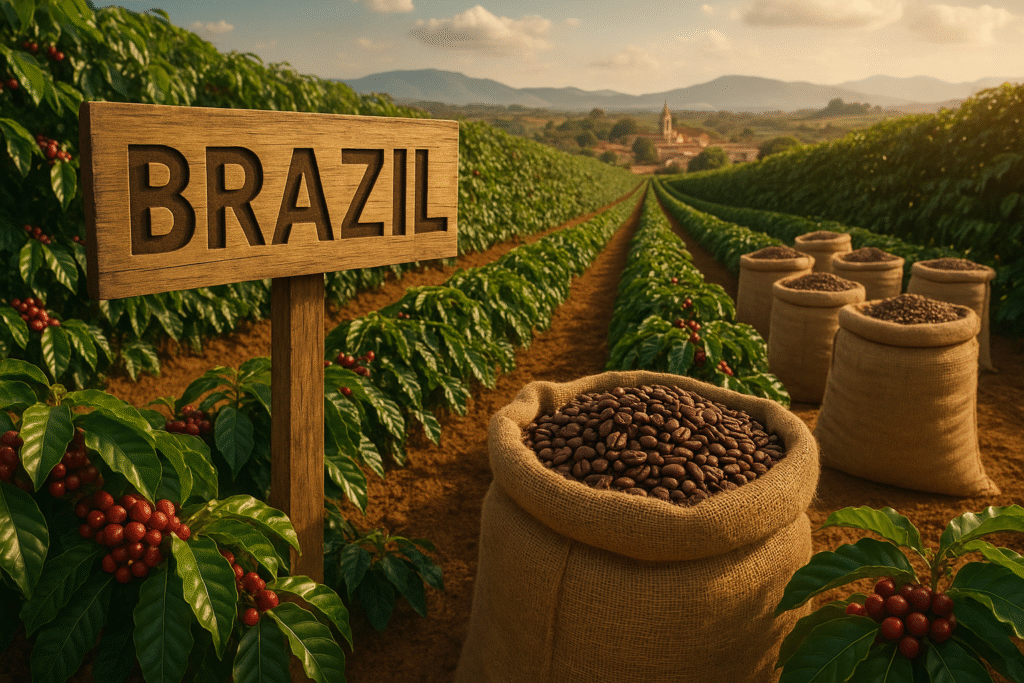When people think of coffee, one country almost always comes to mind: Brazil. For over a century, Brazil has been the undisputed leader in global coffee exports, responsible for about one-third of all coffee traded worldwide. But how did this South American giant become so dominant in the coffee industry?
In this article, we’ll explore the history, geography, economic impact, and modern innovations that helped Brazil secure its place as the world’s coffee powerhouse.
A Brief History of Coffee in Brazil
Coffee was first introduced to Brazil in the early 18th century, around 1727, through a Portuguese colonist who smuggled seeds from French Guiana. Initially, coffee was planted for domestic consumption, but by the early 19th century, Brazil began exporting coffee in significant quantities.
By the late 1800s, Brazil had overtaken other coffee producers and became the largest exporter of coffee in the world, a title it has maintained ever since.
Key historical milestones:
- 1820s–1880s: Coffee plantations expanded rapidly in the southeast regions, particularly in São Paulo and Rio de Janeiro.
- 1888: The abolition of slavery led to a major labor shift, bringing in European immigrants, especially Italians, to work in coffee farms.
- 20th century: Brazil faced boom-and-bust cycles but remained resilient, continuing to innovate and expand its production.
Ideal Climate and Geography
Brazil’s natural conditions make it perfect for coffee cultivation:
- Latitude: Most plantations lie between the Tropic of Capricorn and the Equator — ideal for growing coffee.
- Altitude: Many regions are located between 600 and 1,200 meters above sea level.
- Climate: Warm temperatures, well-distributed rainfall, and distinct dry and wet seasons.
- Soil: Fertile and well-drained, particularly in the Cerrado and Sul de Minas regions.
These conditions allow Brazil to produce both Arabica (higher quality, more complex flavor) and Robusta (stronger, more bitter) beans.
The Scale of Production
What truly sets Brazil apart is the scale of its coffee operations:
- Brazil produces over 60 million 60-kg bags of coffee annually.
- It has more than 300,000 coffee farms, ranging from small family-owned plots to massive industrial plantations.
- States like Minas Gerais, São Paulo, Espírito Santo, and Bahia lead national production.
Unlike many other coffee-producing countries that rely primarily on smallholder farms, Brazil uses advanced mechanization and technology, boosting productivity and consistency.
Economic and Global Impact
Coffee plays a major role in Brazil’s economy:
- It contributes significantly to agricultural GDP and export revenues.
- Brazil’s coffee industry supports over 8 million jobs, directly and indirectly.
- The country exports to more than 120 nations, including the U.S., Germany, Italy, and Japan.
Because of its vast and stable supply, Brazil also helps regulate global prices. When Brazilian crops suffer from drought or frost, the effects are felt throughout the world market.
Coffee and Brazilian Culture
Beyond economics, coffee is deeply woven into Brazil’s cultural identity. Brazilians are among the world’s top coffee consumers, with coffee playing a central role in daily life:
- Cafézinho (a small cup of strong coffee) is offered as a symbol of hospitality.
- Coffee is consumed during breakfast, after lunch, and in social meetings.
- The beverage is celebrated in literature, music, and art.
Coffee is not just a crop — it’s a national icon.
Innovation and Sustainability
In recent decades, Brazil has taken bold steps to modernize and sustain its coffee industry:
- Precision agriculture: Using drones, soil sensors, and satellite imaging to optimize productivity.
- Sustainable certifications: Many farms are now Rainforest Alliance and UTZ certified.
- Water-efficient processing: Adoption of eco-friendly washing and drying methods.
- Quality-focused production: A surge in specialty coffee exports that compete globally.
Brazil is no longer just a mass producer — it’s now also recognized for premium coffee and ethical farming practices.
Challenges Along the Way
Despite its dominance, Brazil faces serious challenges:
- Climate change: Rising temperatures and irregular rainfall threaten crop stability.
- Frosts and droughts: These extreme events can devastate harvests and spike global prices.
- Labor issues: Mechanization has reduced job availability in some rural areas.
However, with its scale, infrastructure, and research institutions, Brazil is better positioned than most countries to adapt to these threats.
Looking Ahead: The Future of Brazilian Coffee
Brazil is expected to remain a leader in coffee production well into the future. Ongoing investments in research, sustainability, and infrastructure are paving the way for:
- Higher yields with less environmental impact
- Stronger international partnerships
- More specialty and gourmet offerings
- Enhanced traceability and transparency for consumers
As the global demand for coffee grows, Brazil’s role will continue to be crucial in shaping the future of the coffee industry.
Final Thoughts: A Legacy Brewed Over Centuries
Brazil’s journey from a modest colonial crop to the world’s coffee superpower is a story of innovation, resilience, and passion. It’s a country that not only exports more coffee than any other but also elevates the entire industry with its advancements and traditions.
So, the next time you take a sip of your morning coffee, there’s a good chance those beans came from Brazil — a nation where coffee isn’t just an export, it’s a legacy.
